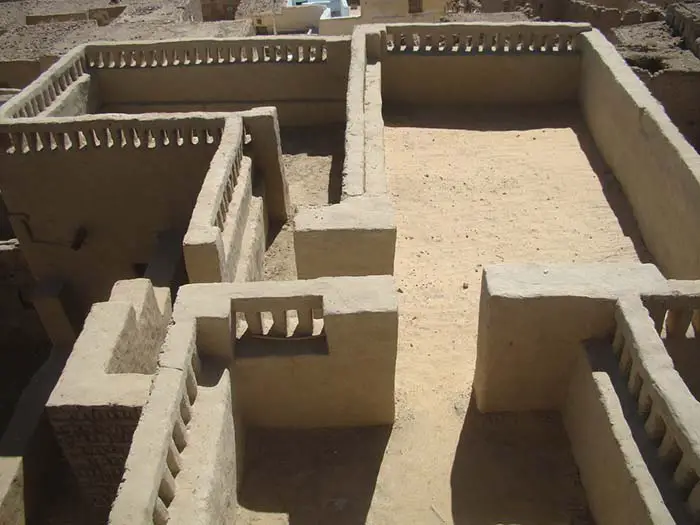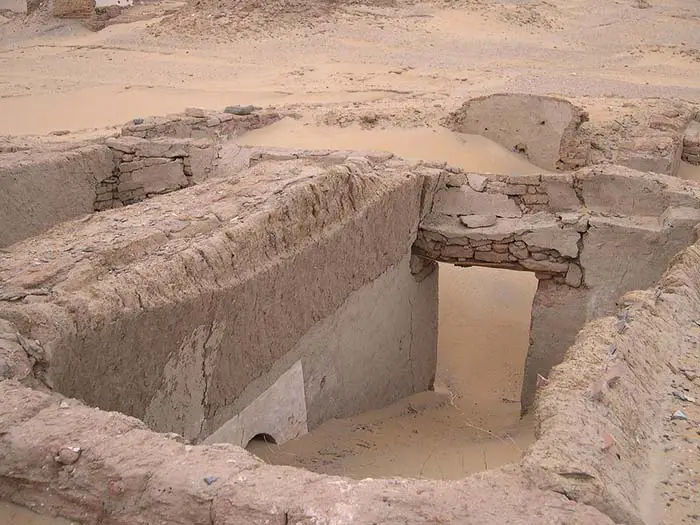Ancient Egypt Houses
For the most part ancient Egypt houses were constructed using materials that were handy and plentiful. This meant that the design of houses in ancient Egypt varied little, even among the wealthy. This makes it very easy to imagine what Egyptian houses look like.
History and Description of Ancient Egyptian Houses
What were the ancient Egyptian houses made of?Egypt’s intense sun and heat shaped how ancient Egyptians built their houses. The oldest houses were built of mud and papyrus. After a while, however, people realized that this combination wouldn’t work. The Nile River flooded for three months every year and literally washed these houses away.
This is when the ancient Egyptians discovered that they could create bricks out of clay and mud from the Nile’s riverbank. Mixing the clay/mud with water, they poured this mixture into wooden molds in the shape of bricks. Allowed to dry in the sun, mud-bricks lasted much longer than houses made of mud and papyrus, but rain still eventually eroded them. Wood wasn’t used to build the actual houses because of its scarcity. It was used to support doorways, ceilings and steps.
Slaves and children as young as four were left to the menial job of making mud-bricks. They would transport the clay and mud, make the bricks and also transport the dried bricks to the building site.
Almost all ancient Egypt houses were constructed with a flat roof. Not only did this most likely make the construction process simpler, but the flat roofs also offered a welcome respite from the burning Egyptian sun. Families often lounged, ate and slept on the roofs of ancient Egypt houses.

Photo by Iris Fernandez (2009). © 2009 Iris Fernandez (used with permission) photographed place: (El-Qasr) Reused in accordance with the Creative Commons Attribution 2.0 license - Recreation of a mud-brick house
Layout of ancient Egyptian houses
The layout of an ancient Egyptian house was largely determined by whether the family was rich or poor, and if they lived in the city or the country.
Houses for the Poor
Those without much money often had only a one room house. This room was used for storage and napping during the day to escape the excessive heat. Inside the room were woven mats made of straw, perhaps a wooden stool or even a wooden bed with string pulled across it. They used long grass and animal hair for the string.
A ladder, mud brick staircase or ramp led to the flat roof. People often slept on the roof at night because it was cooler than the enclosed room below. Sometimes these roofs had reed canopies to create shade.
All the windows and doors had reed mat coverings to help keep out the heat, dust and flies. Oftentimes, doors were built four feet or so up off the ground to prevent the dust from creeping in. A ramp was used to get into the house from the outside.

Photo by Amheida Staff (2004). © 2004 NYU Excavations at Amheida Photographed place: Kellis (Esment el-Kharab). Reused in accordance with the Creative Commons Attribution 2.0 license - Remains of interior chambers
The single room led to an open courtyard with a wall around it. Here, people might have a vegetable garden, they cooked food on clay braziers (a type of portable grill), they spun flax into linen and the family’s stock of goats and chickens roamed the courtyard.
No bathrooms existed inside the poor person’s house. When people had to use the bathroom they had a few options. They could dig a hole, toss the waste into the Nile River, walk to the edge of the village, or use a chamber pot inside the house and then empty it outside. In some cases, people had an outhouse built in the corner of their courtyard.
No running water existed in these houses. The kids or slaves were required to go into the village for buckets of water and bring them back to be used for drinking, cooking and bathing.
If the person lived in the city, these houses were built very close together, much like townhouses today, with a shared wall. The downstairs room was used for the family business, such as a bakery or workshop. The upstairs room was reserved for the family. In towns where pyramids were being constructed, homes were provided for the pyramid workers.
Where poor people had one layer of brick to build their homes, wealthy people often used two or three layers of mud-brick. Still, the richest people had their homes made of stone that often boasted a granite gateway that could be locked from the inside. Keys have been found dating back to 1550 BC.
Houses for the Rich
The wealthy enjoyed building their homes along the Nile River. The outside of the homes was painted white to keep it cooler during the day. Sometimes, the very wealthy lined the outside walls with limestone, which caused their house to sparkle and twinkle in the sunlight. Artists were paid to decorate the inside walls with bright pastel colors to create a fresh and clean feel.
Some of the richest had houses as big as 30 rooms. Most of these rooms were used for storing sealed jars of food. Other rooms were used for the children, guest rooms and even bathrooms (though with no running water). These large homes had front and back doors with bars on the windows to keep out intruders and wild animals.
Raised up, at the center of the house, lay the living or family room. This room was raised up to keep sand out. As it was the center of the home, it was cool in the summer and warm in the winter.
A nobleman might have a master suite behind the living room complete with its own toilet. Pipes led from the bathroom to the garden, though there was no true running water as we know it today.
The rich had more items than the poor, including mirrors, shelves, pots and pans, beds, lighting, heat and fountains. Inside their bedrooms, they had cosmetic and perfume pots and even extra clean clothes.
Outside of the homes of the rich were gardens and pools. Some houses even had pools inside. Many stocked pools with brightly colored fish while the gardens were abloom with cornflowers and daisies.

Photo by Amheida Staff (2006). © 2006 NYU Excavations at Amheida. Reused in accordance with the Creative Commons Attribution 2.0 license - Mud Brick Town Remains at El-Qasr
Ancient Egyptian Houses Facts
- Sometimes, people lived with other families in a house with many rooms and one shared courtyard.
- Sometimes, people shared one room with many families.
- Poor people sometimes had gateways made of limestone.
- Even though some people put bars on their windows, crime was very low in ancient Egypt.
- The braziers people cooked on were made of iron, bronze or clay and held charcoal wood fires.
- The first houses built in ancient Egypt date back to the Predynastic period in the Stone Age around 6,000 B.C.
- Very first ancient homes were built in wattle and daub style, meaning that sticks and twigs were interwoven and then covered with clay or mud.
- The word “adobe” comes from the Ancient Egyptian word “dbe” and means “mud brick.”
